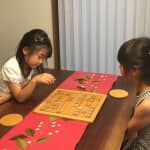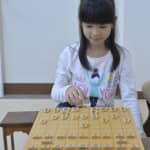Shogi 30 January 2017
Shogi Rules: – How to Play Shogi – : Step 2-2 Moves of Hi/Hisha (Rook) and Kaku (Bishop)
Explore art of Shogi. A professional Shogi player invites you to the world of Shogi along with traditional Japanese culture.
“Shogi Rules: – How to Play Shogi – “ is now available on the blog of I-tsu-tsu Co., Ltd.
Even a novice player will be able to play a standard Shogi. There are three steps and one step has approximately 10-15 lessons.
You will be able to play Mini Shogi and learn how to play standard Shogi with 9 x 9 squares and 40 pieces in Step 2. It is full of fun!
The previous step
Step 2-2 Moves of Hi/Hisha (Rook) and Kaku (Bishop)
Today’s pieces are Hi/Hisha (Rook) and Kaku (Bishop). They are called major pieces since they can make major moves.
1. Hi/Hisha (Rook)
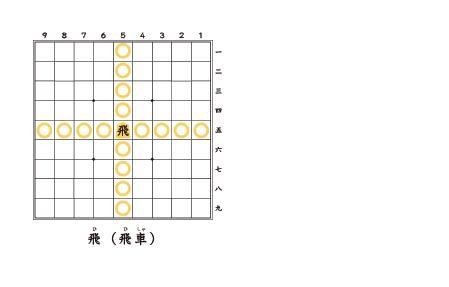
As you see in the above, the total moves of Hi (Rook) look like a plus sign. Hi (Rook) can freely move vertically and horizontally in any number of squares, but it cannot jump over your own piece on the board. Hi (Rook) can capture the opponent’s piece if it is on the way.
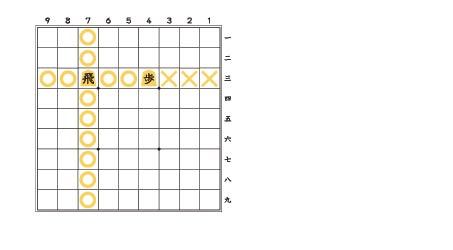
Chinese characters used for Hisha (Rook) mean a flying vehicle. It sounds very cool. I think that a term of vehicle in old times refers to a rickshaw. So, “flying vehicle” sounds fancy. There is a Shogi proverb saying “I had a dream that I was chased by two pieces of Hisha (Rook) ”. This indicates a very terrifying situation where your opponent’s two pieces of Hisha (Rook) are chasing after your Gyoku (King). Even just one piece of Hisha (Rook) is strong enough to attack from a distance, and this piece is considered as a major offensive piece. This proverb says that it is even more threatening if there are two of it.
2. Kaku/Kakugyo (Bishop)

The moves of Kaku (Bishop) make a shape of X. Kaku (Bishop) should also stop if there is your own piece on the way. Kaku (Bishop) cannot jump over your own.
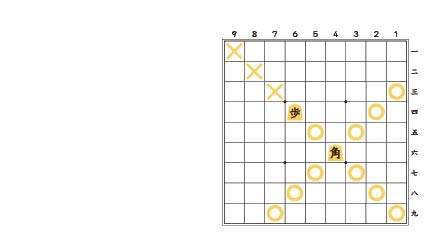
The feature of Kaku (Bishop) is, the best of all, its diagonal beam effective even from a large distance. Kaku (Bishop) cannot jump over your own or the opponent’s pieces. But, if there is any piece on the way, it can move diagonally any squares. Chinese characters used for Kaku (Bishop) mean “going to a corner” since it can go to the corner of a board.
There is a Shogi proverb saying “With a watchtower Kaku (Bishop), there must be a brilliant move.” It means that Kaku (Bishop) should stay in a distance with its effective beam aiming at the opponent’s camp and pieces rather than actually approach them.
The most common first move is P-7f (Fu (Pawn) moves to the square of 7f). This is because Kaku (Bishop) beam can be activated by moving Fu (Pawn) on the square of 7g.
Now, carefully look at the Chinese character of Kaku (Bishop). The center line goes all the way down. The old style Chinese characters are adopted to Shogi pieces, and they are different from what children learn at school. So, please be careful when you take a test at a school.
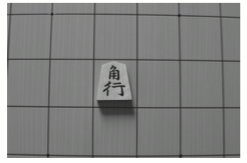
So, you have learned all the 8 types of Shogi pieces. It is difficult to memorize perfectly all pieces’ moves and play a game. So, don’t be a perfectionist.
You can play a game of Shogi with a manual having beside your board.
For your reference, you can place an order for a list of piece moves available at our site.
Comments from the girls’ mom
My girls have learnt all the piece moves. It was surely difficult at first and they mixed up Hisha (Rook) with Kaku (Bishop), and Kin (Gold) with Gin (Silver). Looking at them in the lessons, I thought that a key for them to memorize the moves depends on how strongly impress them with the piece moves. For example, it is good to give them an interesting analogy such as Kin’s moves look like a shape of a mushroom. They also enjoyed learning Kaku’s moves saying “Kaku (Bishop) can move all the way to a corner. So it’s got an X shape move”. They asked each other which piece was their favorite. The younger one likes Kei (Knight) since it can jump and is fun. They seem to find it fun to learn the piece moves once they get a unique characteristic of each piece.
The next step



